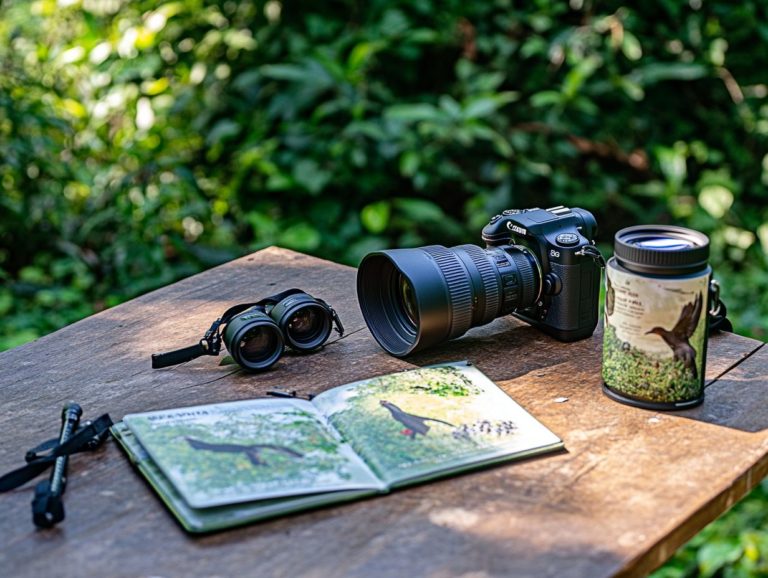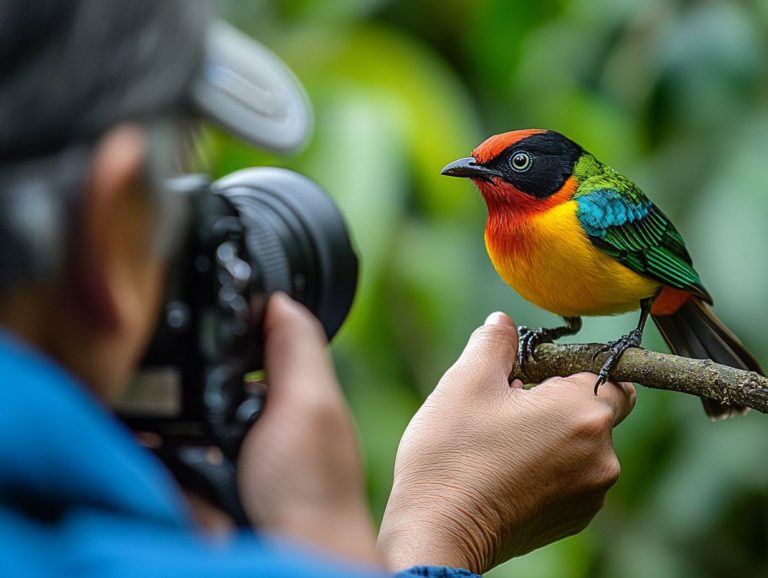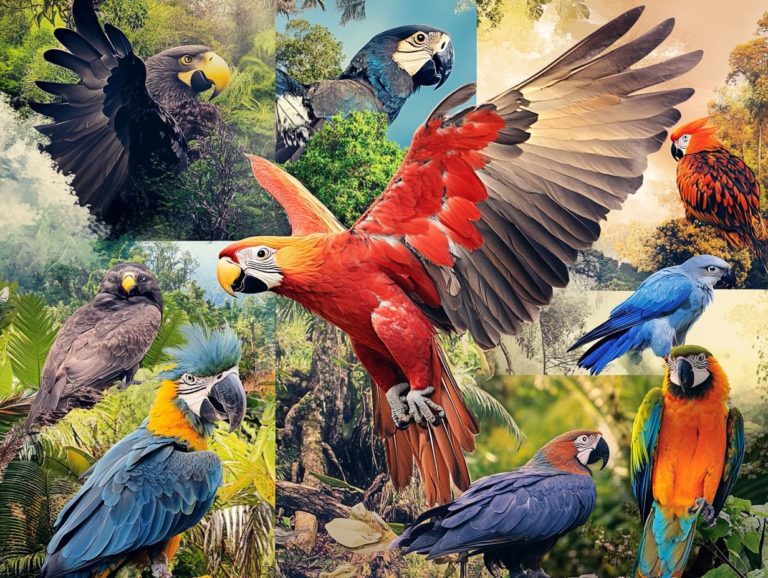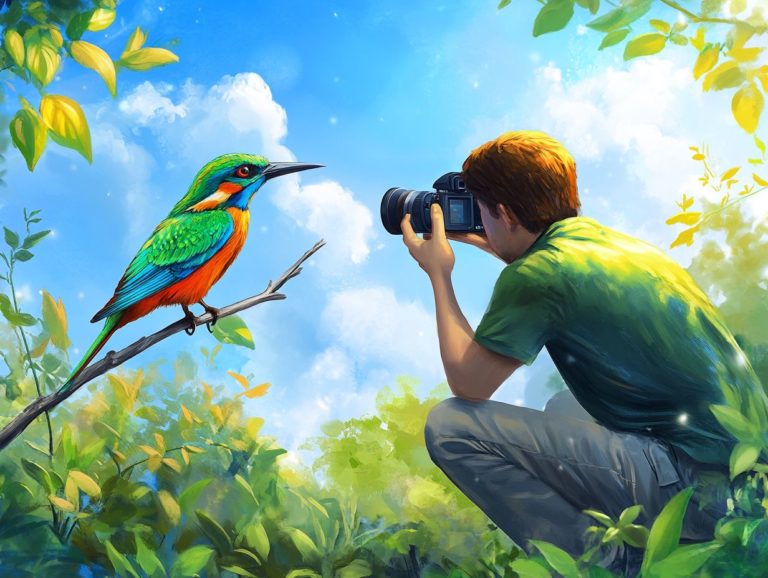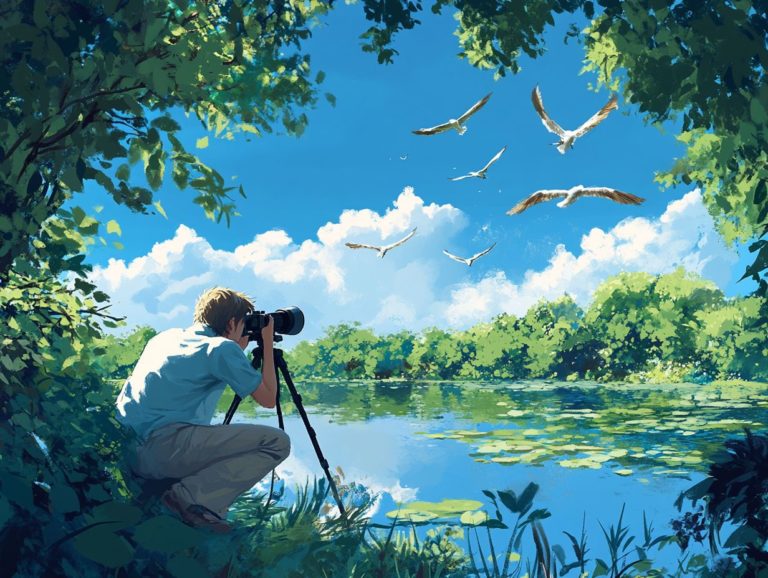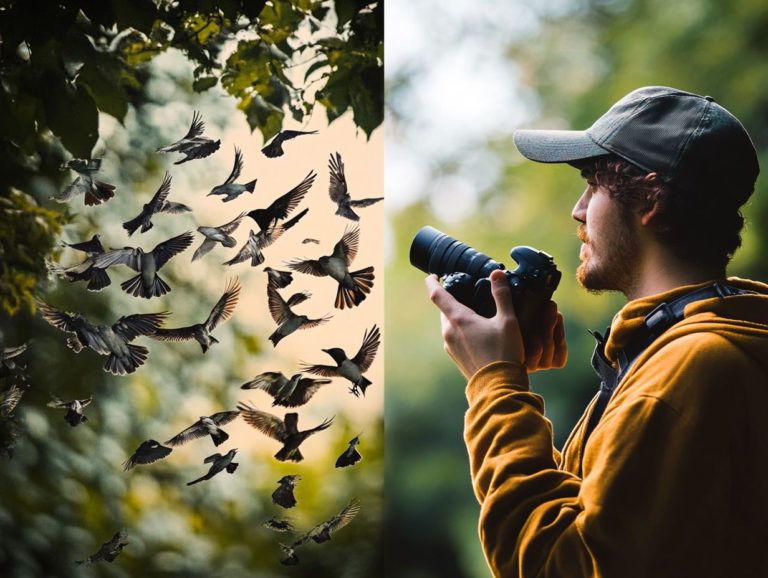Best Tripods for Birdwatching Photography
Birdwatching photography demands a good mix of mobility, stability, and precision. Selecting the right tripod can truly transform your experience, whether you re capturing a fleeting moment in the wild or preparing for an extended observation session.
This guide presents an array of the finest tripods specifically crafted for birdwatching, showcasing remarkable features such as lightweight designs, robust constructions, and adjustable heights.
From budget-friendly selections to sophisticated models, you ll discover options that will elevate your birdwatching adventures to new heights.
Contents
- Key Takeaways:
- 1. Lightweight and Portable Tripods
- 2. Sturdy and Stable Tripods
- 3. Tripods with Adjustable Height
- 4. Tripods with Smooth Pan and Tilt Movements
- 5. Tripods with Quick Release Plates
- 6. Carbon Fiber Tripods
- 7. Aluminum Tripods
- 8. Tripods with Multiple Leg Sections
- 9. Tripods with Rubber Feet for Better Grip
- 10. Tripods with Center Column Hook for Added Stability
- 11. Tripods with Removable Center Column for Low-Level Photography
- 12. Tripods with Ball Head or Gimbal Head
- 13. Tripods with Monopod Conversion
- 14. Tripods with Water and Dust Resistant Features
- 15. Tripods with Budget-Friendly Options
- Frequently Asked Questions
- Looking for the best tripods for birdwatching photography? Here are our top 5 picks!
- What features should I look for in a tripod for birdwatching photography?
- Is a carbon fiber tripod better than an aluminum one for birdwatching photography?
- Can I use a regular camera tripod for birdwatching photography?
- What is the average price range for a good tripod for birdwatching photography?
- Can I attach a spotting scope to a tripod for birdwatching photography?
Key Takeaways:
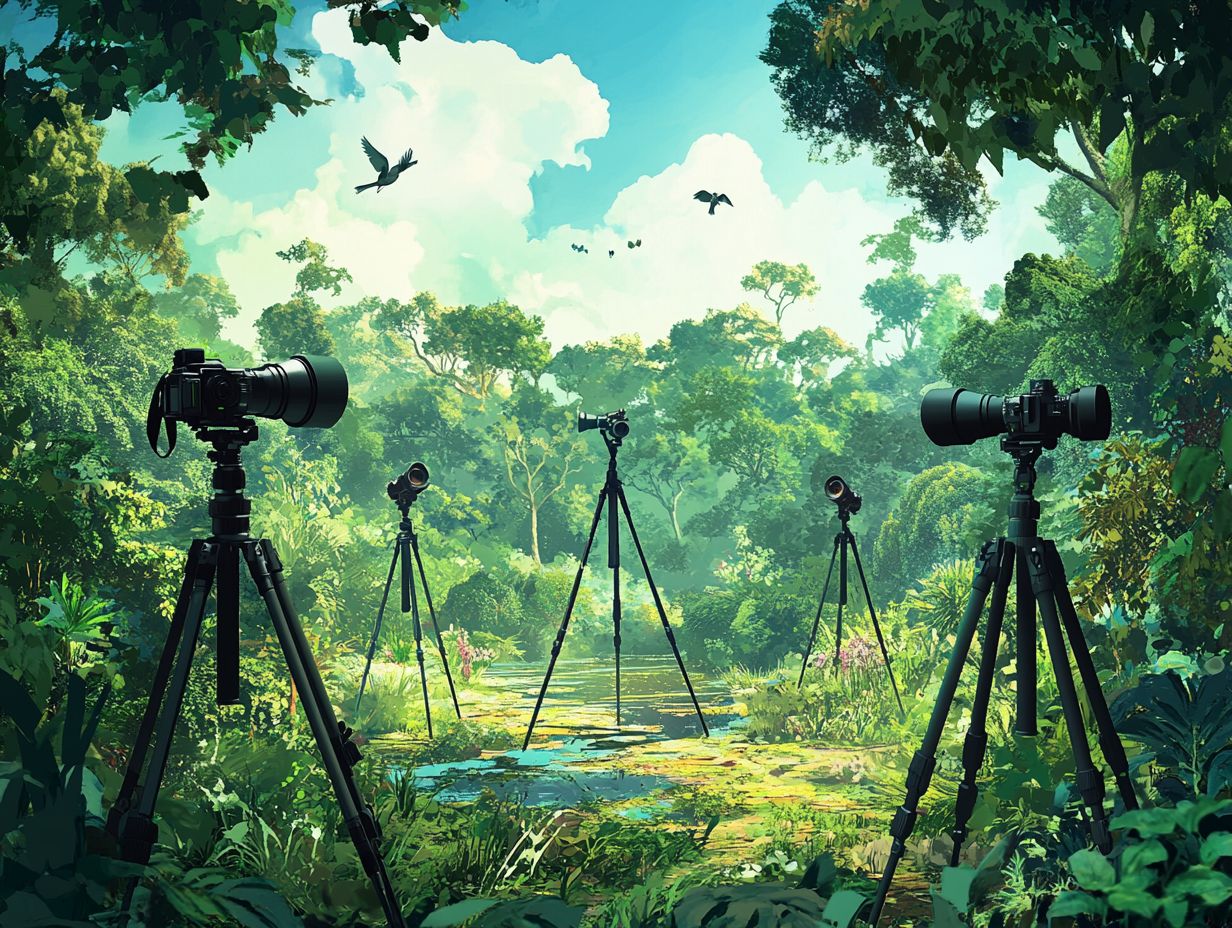
- Choose lightweight tripods for easy transport.
- Sturdy tripods keep your camera steady and your photos sharp.
- Look for adjustable-height tripods for various shooting angles.
1. Lightweight and Portable Tripods
When you embark on a photography adventure in Southern Australia, having a lightweight tripod can change everything. It helps you capture stunning wildlife moments without the burden of heavy gear.
The importance of lightweight tripods is significant. Models made from carbon fiber offer the perfect blend of stability and portability. These tripods are a game-changer for birdwatching and landscape shooting.
For instance, when capturing the rapid movements of birds in flight, a sturdy yet lightweight tripod minimizes vibrations. This leads to sharper, more precise images.
If you re striving for that perfect landscape shot at sunrise, a compact tripod allows for swift setup and adjustments. It prevents fatigue from slowing you down!
These advantages enable you to remain agile and responsive in dynamic environments, ensuring that you never miss capturing that perfect moment.
2. Sturdy and Stable Tripods
For serious wildlife photography, a sturdy tripod is a must. It holds your heavy gear steady, even in tricky terrains like Southern Australia.
Models from RRS and Acratech truly shine with their robust construction. This gives you peace of mind to focus on capturing the perfect shot without worrying about stability.
Gimbal heads are especially useful for wildlife photographers. They are specialized tripod heads that help you smoothly follow moving subjects, whether you’re capturing delicate bird flutters or fast-moving animals.
These heads facilitate rapid adjustments, ensuring that each moment is flawlessly framed. Finding the right tripod and head combination caters to all your photographic needs!
3. Tripods with Adjustable Height
Adjustable-height tripods are crucial for wildlife photography, and using must-have accessories for bird photography can further enhance your experience. They let you easily find the best shooting angle, no matter the terrain.
These tripods often come with a reliable locking mechanism. Twist or flip locks make height adjustments a breeze! You can aim for low-angle shots of elusive wildlife or seek elevated views of expansive landscapes.
With sturdy legs providing impressive stability, you can trust that every shot will remain sharp and steady. Quick-release plates enhance your experience by allowing you to transition effortlessly between locations.
This kind of adaptability boosts your efficiency and invites you to experiment with innovative angles, enriching your creative possibilities and transforming the way you capture the world around you!
4. Tripods with Smooth Pan and Tilt Movements
Achieving smooth pan and tilt movements is crucial for your landscape photography and wildlife encounters. This capability allows you to effortlessly follow fast-moving subjects or capture expansive scenes without sacrificing image quality. Selecting the right tripod head is key.
Regarding choosing a tripod head, you ll find various options designed to meet specific shooting needs. Fluid heads allow for buttery-smooth movements, making it easier to follow moving subjects, and are particularly popular for videography and wildlife photography.
Fluid heads provide seamless, controlled movements, ensuring that your shots remain steady even when tracking swift animals.
Conversely, ball heads offer rapid adjustments and can be used in many situations, making them the go-to choice for landscape photography and multi-row panoramic sessions. When precise positioning and quick changes are essential, these heads can significantly enhance your workflow.
Ultimately, the decision between these two types of heads can profoundly impact not just your shooting experience but also the quality and creativity of the images you capture.
5. Tripods with Quick Release Plates
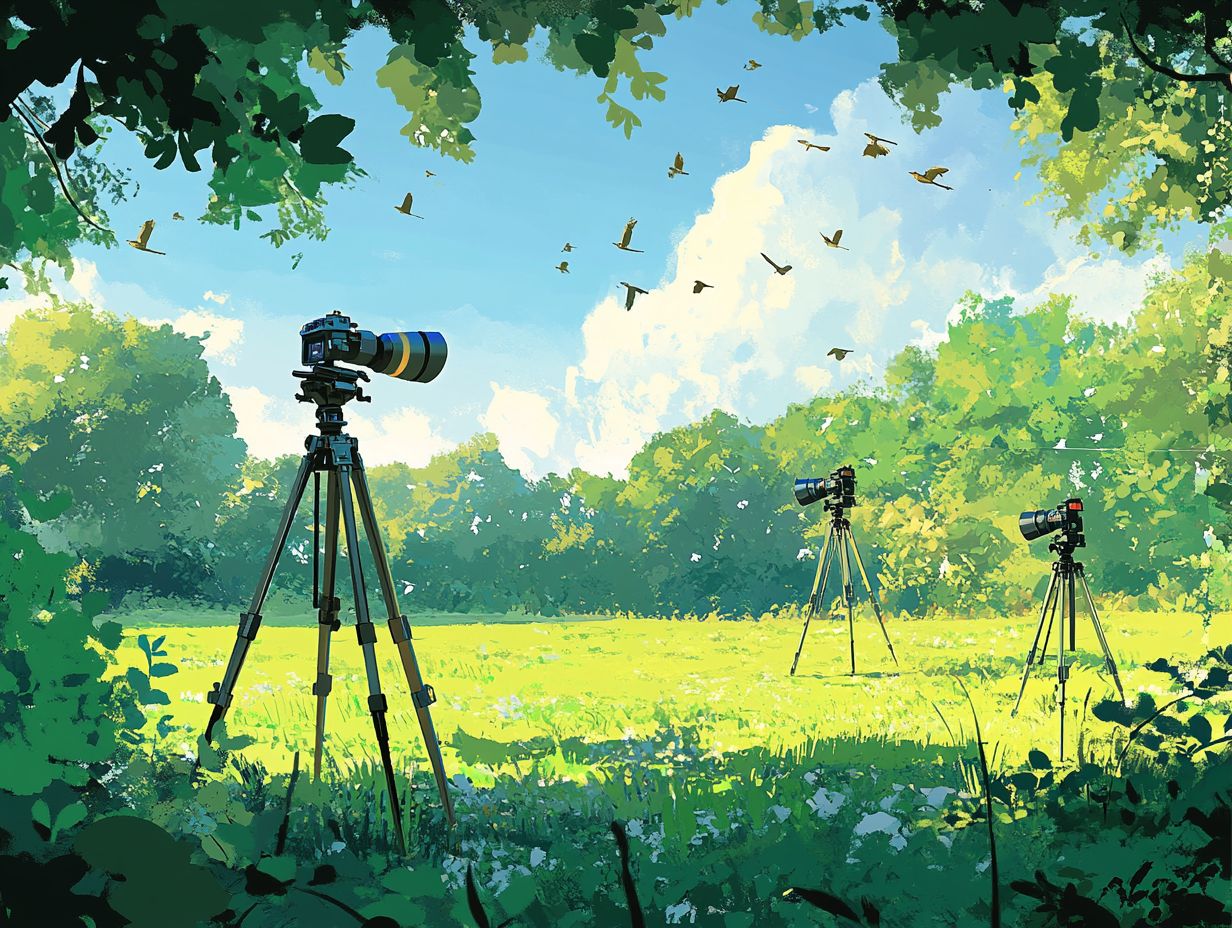
Tripods equipped with quick-release plates provide unparalleled convenience for photographers on the move, particularly during photographic expeditions in Southern Australia, where every second counts in capturing fleeting wildlife moments.
These adaptable plates facilitate effortless transitions between setups, enabling you to swiftly shift from a stable landscape shot to tracking agile animals, so you never miss a precious moment!
Renowned brands like Manfrotto and Gitzo offer models featuring this capability, delivering sturdy yet lightweight options that seamlessly work together with various camera rigs.
With a simple click-and-release mechanism, you can optimize your shooting potential without wasting invaluable time fumbling with gear, ultimately amplifying your creative expression across diverse environments.
6. Carbon Fiber Tripods
Carbon fiber tripods are truly the gold standard for serious photographers, especially if you’re diving into wildlife photography in Southern Australia. They combine lightweight design with super stability, making them perfect for your adventurous photography!
Their durability really stands out in a variety of weather conditions, allowing you to navigate everything from scorching heat to unexpected rain with ease. You can trust that your gear will remain secure and intact, no matter what Mother Nature throws your way.
Popular models like the Gitzo Series 1 and Manfrotto Befree Advanced are particularly esteemed for their robust construction and impressive load capacity. This means you can easily support larger camera setups without sacrificing weight.
For wildlife photographers like yourself, this lightweight nature is essential, especially when you’re trekking long distances in search of that perfect shot. These tripods make transport effortless, enabling you to capture stunning images without the hassle of lugging around unnecessary equipment.
7. Aluminum Tripods
Aluminum tripods present a compelling choice for photographers like you who seek an ideal blend of affordability and stability. This is particularly advantageous when you’re setting off on photographic adventures in Southern Australia, where weight restrictions often come into play.
These robust yet lightweight tools cater to both amateur and professional photographers, offering versatility in many situations. The durability of aluminum tripods typically enables them to handle diverse terrains, making them well-suited for challenging environments like wildlife encounters and rugged landscapes.
Budget-friendly models also provide impressive stability without straining your finances, allowing you to capture breathtaking images without a hefty investment.
Keep in mind that aluminum tripods may not match the lightweight ease of carbon fiber alternatives. This could impact your portability during those long hikes or extensive shooting sessions.
8. Tripods with Multiple Leg Sections
Tripods with multiple leg sections offer you exceptional versatility. They allow you to reach your desired maximum height while ensuring stability across diverse terrains you might encounter while photographing in Southern Australia.
These adjustable legs provide remarkable adaptability, especially in challenging landscapes like rocky outcrops, sandy dunes, or uneven ground. You can extend or retract each leg independently, securing a stable footing on slopes or irregular surfaces.
For example, when capturing the vivid sunrise over the Twelve Apostles, the ability to adjust leg lengths becomes crucial for nailing that perfect angle and level shot.
Brands such as Manfrotto and Gitzo are highly regarded for their innovative designs featuring multiple leg sections. They effortlessly combine durability with user-friendly functionality, enhancing the creative opportunities available to you as a landscape photographer.
9. Tripods with Rubber Feet for Better Grip
Tripods equipped with rubber feet provide enhanced grip and stability. They are essential tools for wildlife photographers navigating the often uneven and unpredictable outdoor conditions of Southern Australia, especially when using a Sony 600mm lens.
These specialized feet serve as a buffer against slick surfaces like wet rocks or loose gravel. They ensure that your tripod remains firmly planted, even in the most challenging environments.
Capture those fleeting moments of animals in their natural habitat. You often find yourself perched on steep inclines or muddy banks, where a slip could ruin the shot and pose a safety risk.
During landscape shooting at dawn or dusk, when light is scarce and conditions can change rapidly, the right tripod stabilizes your camera for long-exposure shots, a technique that allows you to capture images with more light. This grip and balance let you focus on creativity and composition.
10. Tripods with Center Column Hook for Added Stability
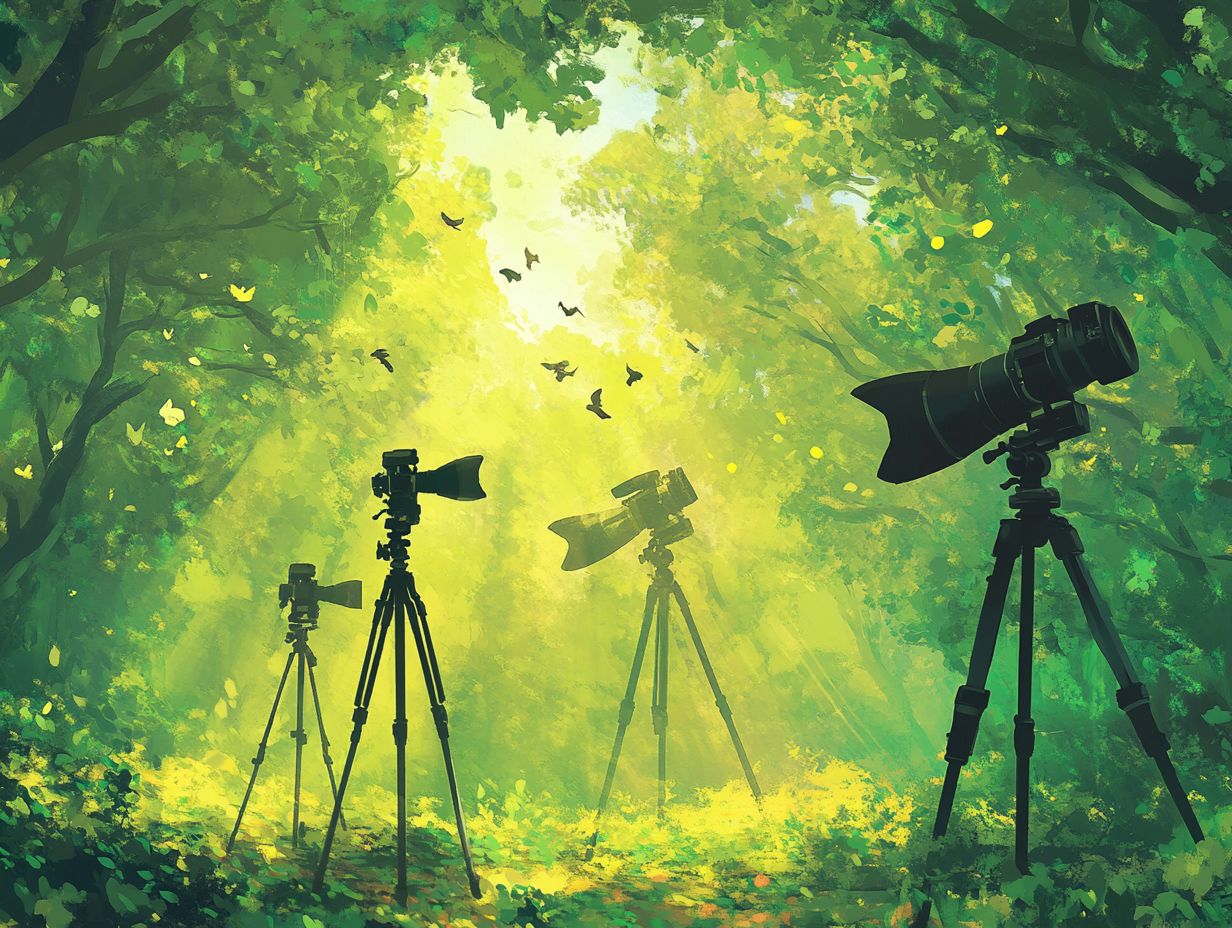
A tripod with a center column hook can elevate your photography game by providing added stability. This feature allows you to attach extra weight, especially beneficial when capturing wildlife in the varied landscapes of Southern Australia, where windy conditions can be common, particularly with a Sony 600mm lens.
In these situations, you can easily secure a sandbag or another heavy object to the center column hook. This greatly reduces the chances of your tripod toppling or swaying.
This becomes essential not just during blustery coastal shoots but also in open grasslands, where strong gusts can disrupt your composition. When working with long lenses to capture distant wildlife, the stability gained from that extra weight ensures sharper images and steadier framing.
Ultimately, a tripod equipped with a center column hook enhances your overall performance. Immerse yourself in your craft without the nagging worry of equipment mishaps.
11. Tripods with Removable Center Column for Low-Level Photography
The option of a removable center column in tripods greatly enhances your versatility, allowing you to engage in low-level photography and capture unique perspectives during wildlife encounters in captivating locations like Southern Australia, particularly when using a spotting scope tripod.
This innovative feature allows you to shoot from the ground up, showcasing intricate details of flora and fauna in their natural habitat. It also invites you to unleash your creativity in composing shots that break away from typical eye-level perspectives, capturing multi-row panoramic photos with ease.
Models like the Manfrotto Befree Advanced and Gitzo Traveler, along with options like ProMediaGear GT2 Tomahawk, offer various height options with removable columns. These are excellent choices for both wildlife and landscape photography.
You can experiment with angles, emphasizing foreground elements while smoothly blurring distant landscapes. This transforms ordinary shots into breathtaking images that tell a story. This flexibility is key to elevating your photography from standard to visually striking masterpieces, especially when capturing the enchanting vistas and diverse wildlife that Australia has to offer.
12. Tripods with Ball Head or Gimbal Head
Choosing between a ball head and a gimbal head is crucial for your wildlife photography adventures, especially when capturing the vibrant scenes of Southern Australia. Each option has unique benefits that can enhance your shooting experience.
A ball head shines in versatility, making it ideal if you appreciate quick adjustments and a compact setup, perfect for the ever-changing landscapes of bushland or coastal areas. With this setup, you can effortlessly pivot your camera for various angles, invaluable for photographing elusive creatures darting through the underbrush.
If your focus is on larger wildlife like eagles or kangaroos, a gimbal head gives you great stability and easy movement. Brands like RRS provide high-quality gimbal heads perfect for balancing hefty telephoto lenses. FlexShooter heads excel in both fast-paced and steady shooting situations. Your choice depends on your specific needs and shooting style.
13. Tripods with Monopod Conversion
Tripods that offer monopod conversion provide remarkable versatility and a travel-friendly solution, allowing for quick adjustments during wildlife encounters. This ensures that you seize every photographic opportunity effectively.
This feature is a game changer for photographers in dynamic environments where mobility is key, particularly during unexpected animal movements or shifts in lighting. Models like the Manfrotto Befree or the Benro Adventure series transition seamlessly from tripod to monopod, delivering enhanced stability without sacrificing portability.
The ability to swiftly switch to a monopod grants you greater freedom of movement, crucial for capturing fleeting moments in nature. You can travel lighter, making it easier to carry your gear on long hikes or while navigating through dense brush, ultimately making every outing more productive and enjoyable.
14. Tripods with Water and Dust Resistant Features
Investing in tripods with water and dust-resistant features is essential for photographers navigating the unpredictable landscapes of Southern Australia. These tripods ensure durability and reliability in any conditions you encounter during your photographic adventures.
When exploring rugged terrains or capturing captivating wildlife, a tripod that handles unexpected rain or muddy conditions becomes invaluable. Models like the Manfrotto 055 and Gitzo Series 1 stand out, crafted from robust materials that resist corrosion and maintain functionality even in harsh weather.
These durable options do more than survive the elements; they provide the stability needed for capturing steady shots crucial when photographing elusive animals or breathtaking vistas at dawn as the light shifts. By prioritizing weather-resistant features, you can enjoy peace of mind, allowing you to immerse yourself in your craft without worrying about your gear.
15. Tripods with Budget-Friendly Options
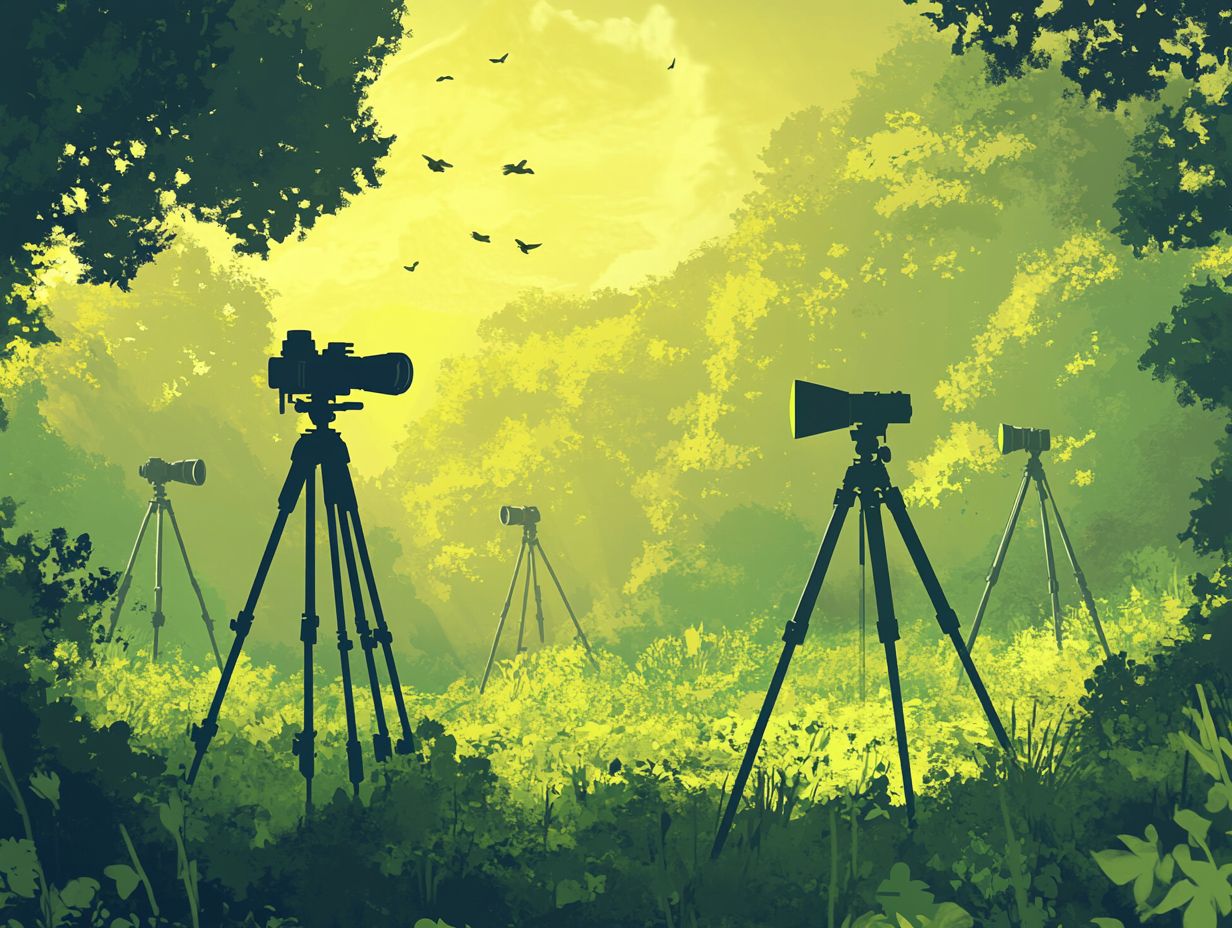
For photographers on a budget, it is easy to find high-quality yet affordable tripods. This allows you to pursue wildlife photography in Southern Australia, including options from brands like Amazon Basics or Vanguard without straining your finances. With an abundance of options in today s market, it is essential to seek out brands that focus on quality while maintaining reasonable prices.
Look for models that feature robust construction, versatile height adjustments, and efficient locking mechanisms. Brands like Sunpak and the lighter models from Manfrotto are worth your attention. They have established a reputation for delivering exceptional value without compromising stability. When choosing a tripod, consider how much weight the tripod can hold and material; carbon fiber, though on the pricier side, can greatly enhance portability and durability.
Choosing the right tripod improves your photography, whether you re capturing portraits or landscapes. With the right tripod, you can capture stunning wildlife photos without breaking the bank while considering your baggage allowance and weight restrictions.
Frequently Asked Questions
Looking for the best tripods for birdwatching photography? Here are our top 5 picks!
The top 5 best tripods for birdwatching photography are the Gitzo GT2542 Mountaineer Series 2 Carbon Fiber Tripod, Manfrotto 055XPROB Pro Tripod Legs, Vanguard Alta Pro 263AB 100 Aluminum Tripod, Benro Adventure Series 2 Aluminum Tripod, and Sirui N-2204X Carbon Fiber Tripod. For more information on essential gear, check out our guide on photography gear essentials for birdwatching.
What features should I look for in a tripod for birdwatching photography?
When choosing the best tripod for birdwatching photography, look for a lightweight and sturdy design, adjustable height and legs, a quick-release plate, and a fluid head for smooth panning and tilting. Additionally, consider including essential photography accessories for birdwatching to enhance your experience.
Is a carbon fiber tripod better than an aluminum one for birdwatching photography?
While both carbon fiber and aluminum tripods can be suitable for birdwatching photography, carbon fiber tripods tend to be lighter and more durable, making them a popular choice among photographers. Additionally, if you’re interested in enhancing your birdwatching experience, consider learning how to choose a camera for bird watching.
Can I use a regular camera tripod for birdwatching photography?
Regular camera tripods may not be the best choice for birdwatching photography as they may lack the necessary stability and height for capturing birds in their natural habitats. Instead, consider using high-quality binoculars for bird photography that are specifically designed for this purpose.
What is the average price range for a good tripod for birdwatching photography?
The average price range for a good tripod for birdwatching photography is between $100 to $500. However, some high-end tripods can cost upwards of $1000. To ensure you capture the best birdwatching photos, it’s crucial to invest in a sturdy and reliable tripod, as highlighted in the top 5 birdwatching photography gear reviews.
Can I attach a spotting scope to a tripod for birdwatching photography?
Yes, many tripods designed for birdwatching photography come with adapters or plates that allow for easy attachment of a spotting scope. Be sure to check the compatibility of your tripod and spotting scope before purchasing.

